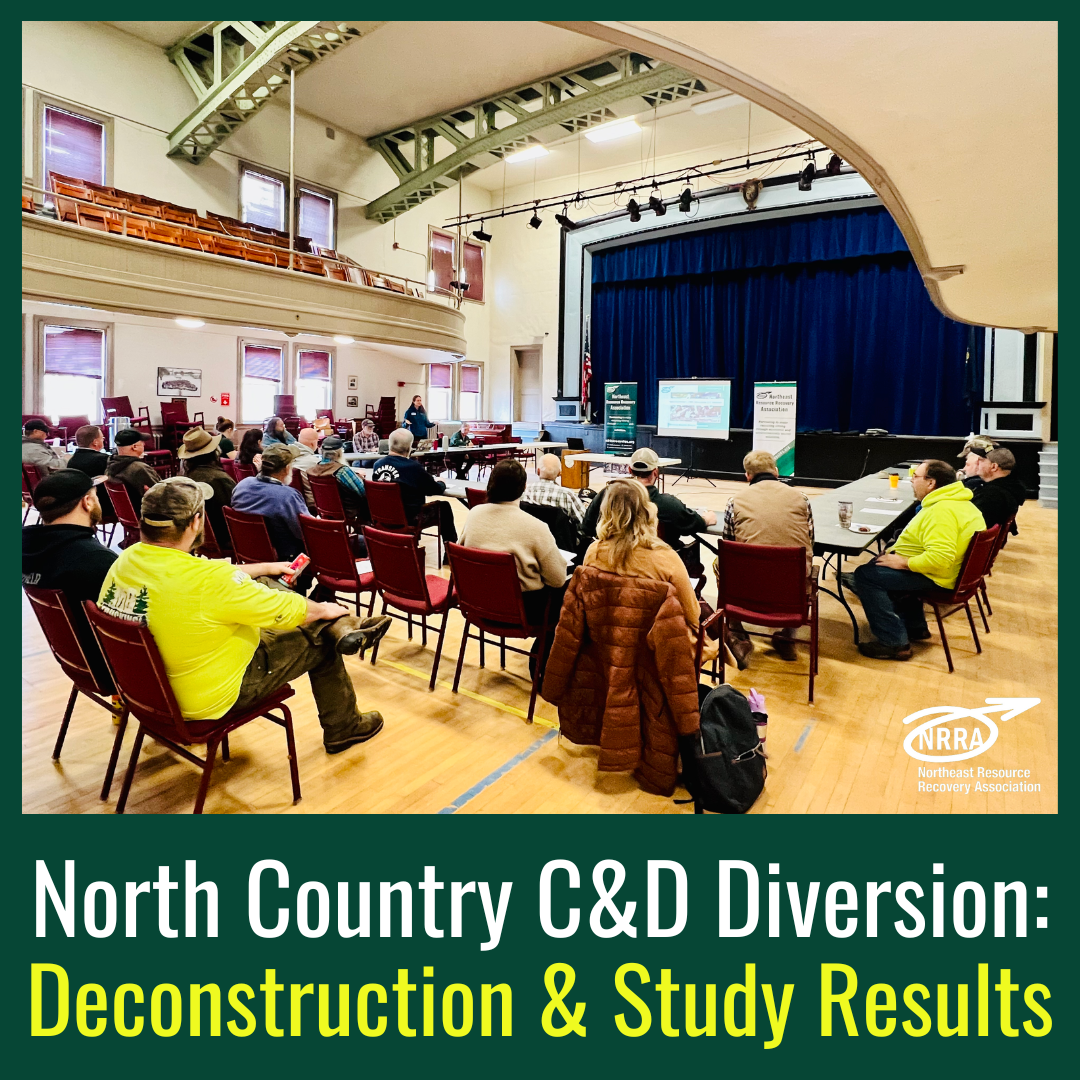North Country C&D Summit - Deconstruction & Feasibility Studies
NRRA held the second of three Summits in Lancaster, NH as part of our EPA grant-funded North Country C&D Diversion 2.0 project, which focuses on bulky waste diversion and reuse; asphalt, brick, and concrete (ABC) recycling; and the idea of deconstruction.
The Summit included 34 attendees representing 15 North Country communities, as well as the EPA, NHDES, and Representative Annie Kuster's office. Senior Member Services Representative, Bonnie Bethune, opened with a presentation on two feasibility studies NRRA completed between the first and second C&D Summit.
Feasibility Study #1: Asphalt, Brick, and Concrete Recycling in the NH North Country
The goal of this study was to identify cost-effective and environmentally responsible options for the crushing and reuse of asphalt, brick, and concrete (ABC) for NH North Country towns. Three potential solutions were explored:
- ABC Pick Up (feasible): Hire a company that can pick up on site and process into a reusable aggregate.
- ABC Delivery (feasible): Find a location where towns can deliver to be processed into an aggregate.
- On-Site ABC Crushing (not feasible): Hire a company to go from town to town to crush into a reusable aggregate or to grind at one centralized location.
The ability and willingness of a local company to provide ABC services, combined with the cost-effectiveness of such services for North Country municipalities, were key criteria for evaluating the feasibility of handling ABC.
Feasibility Study #2: Backhauling C&D from the North Country to a Reprocessing or Reuse Facility
The goal of this feasibility study was to determine if there is a cost-effective and environmentally sound way to backhaul C&D from the North Country to C&D recycling and reprocessing companies. Backhauling entails using the containers and trailers that bring material to North Country landfills to bring back C&D be processed, thus not returning empty.
Of the eight processors and haulers contacted by NRRA, only one had any interest in further exploring the option of backhauling C&D to Resource Waste Services in Epping, NH. The other companies sited state regulations, lack of availability, and lack of available material as reasons why they did not believe backhauling would be feasible.
Deconstruction Panel Presentation and Conversation
We were joined by Frank McClain, Executive Director of the Pemi-Valley Habitat for Humanity ReStore, and Abbey Massaro, Waste Reduction Consultant for the Center for EcoTechnology to speak on deconstruction, C&D management, working with contractors, and the ReStore model.
Frank shared information about the ReStore model as a way to fund Habitat for Humanity building projects. The Plymouth-based ReStore offers whole house clean-outs and a moderately-close option for North Country residents to both bring or purchase working appliances, furniture, and housewares. He encouraged transfer stations to work closely with their planning and zoning departments to share building permits with the transfer station so builders understand the waste impact of their project and transfer stations can be better prepared for a potential influx of C&D.

Abbey provided a brief overview of deconstruction - the unbuilding of a building - and emphasized that oftentimes even partial deconstruction, such as removing windows or doors from a remodel prior to demolition, can be helpful. One difficulty with deconstruction is the relative rigidity of a contractor's timeline, which can be difficult and expensive to disrupt. By including aspects of deconstruction in the initial plan, the time and cost can be built into the timeline and budget. The Center for EcoTechnology works with businesses and contractors to learn more about and put deconstruction in practice.
 Do you know what is special about the year 1945? According to Abbey, this is the most popular year to target deconstruction ordinances in municipalities, since it was prior to the use of adhesives being used in construction, so buildings built in 1945 or earlier are easier to pull apart.
Do you know what is special about the year 1945? According to Abbey, this is the most popular year to target deconstruction ordinances in municipalities, since it was prior to the use of adhesives being used in construction, so buildings built in 1945 or earlier are easier to pull apart.
Finally, NRRA Communications Manager, Andrea Folsom, shared a new resource with attendees - a handout for residents and North Country transfer station users with locations and other ideas for where to donate furniture, appliances, or building material for reuse, including social media, local social services or faith organizations, the Pemi-Valley ReStore, and the Veterans2Veterans Thrift Store.
Next Steps:
The final North Country C&D Diversion 2.0 Summit will be held in September and will recap lessons learned over the course of the year. Prior to the final Summit, NRRA Member Services Manager, Brian Patnoe, will be working with a couple towns to set up C&D and bulky waste diversion programs, which includes setting up a Full Cost Accounting model and a C&D waste audit. He will also be helping two facilities partner together on C&D management. Results of these projects will be shared in the final study.
Resources:
- Asphalt, Brick, and Concrete Recycling in the NH North Country: An NRRA Feasibility Study
- Backhauling C&D from the NH North Country to a Reprocessing or Reuse Facility: An NRRA Feasibility Study
North Country Furniture, Appliances, and Architectural Salvage Reuse & Donation Ideas
This project has been funded wholly or in part by the United States Environmental Protection Agency under assistance agreement HC-00A01372 to Northeast Resource Recovery Association. The contents of this document do not necessarily reflect the views and policies of the EPA.
Northeast Resource Recovery Association complies with applicable Federal civil rights laws and does not discriminate on the basis of race, color, national origin, age, disability, or sex (including pregnancy, sexual orientation, and gender identity).

